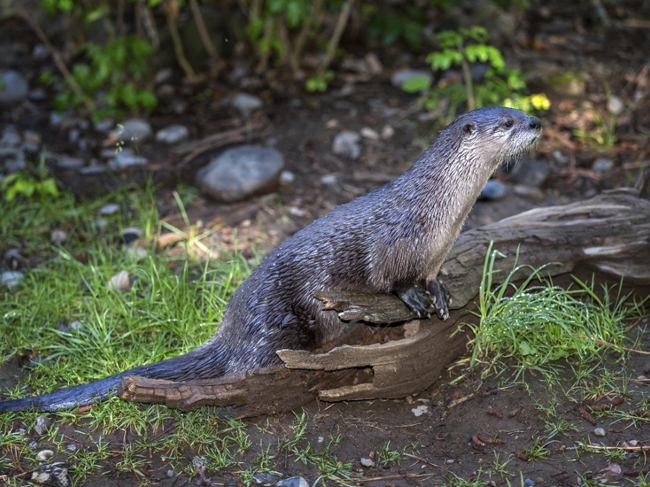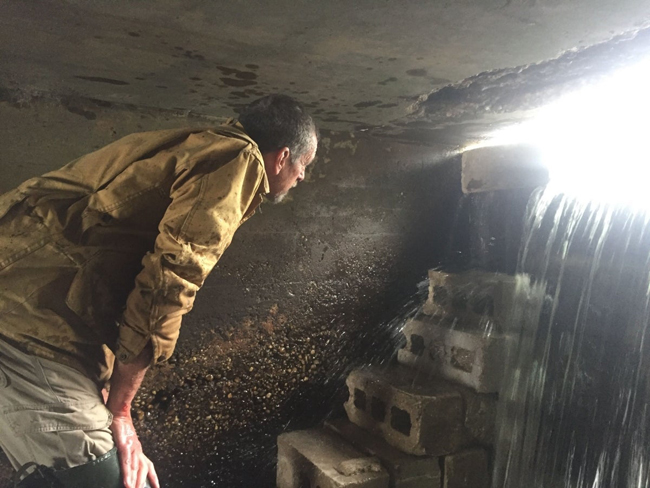River otters have been expanding into new South Shore territory but need safe ways to navigate their new homes
— By Jacqueline Sweet, Patch.com, Islip
Islip, NY, April 23, 2021 - River otters were once common in Long Island freshwater ponds, creeks and rivers. But habitat loss, fur trapping and pollution meant that by the turn of the 20th century a river otter on Long Island was a rare sight. That may be beginning to change.
Biologists from Seatuck Environmental Association, headquartered in Islip, report that they have spotted river otters in two new South Shore homes: the Carmans River in Brookhaven and Eastport's Little Seatuck Creek. Until 2020, otters were only known to inhabit North Shore and Peconic Estuary waters. Two were spotted on the Connetquot River in Oakdale in 2020, signaling the species is expanding, a sign of a healthy ecosystem.
River otters need fresh water and abundant fish to thrive, the experts at Seatuck explain. They also need a way to cross the road.
After an otter died trying to navigate around a dam in Eastport by crossing a road, Seatuck scientists and Brookhaven Town employees constructed a "river stairway," a wooden overpass on the dams, so the otters can avoid roadways.
Mike Bottini is a wildlife biologist at Seatuck.
"Long Island's highly fragmented and developed landscape poses a challenge for otter recolonization in the form of roadkills where otters are forced out of the water and onto roads in order to travel around dams," he said in a news release from the nonprofit.
Seatuck's Long Island River Otter Project team will be partnering with Long Island Sound Study, New York Sea Grant, South Shore Estuary Reserve, and Peconic Estuary Partnership to train volunteers to monitor river otter populations.
Muskrats are a common sight on Long Island rivers and creeks but are smaller than river otters.

River Otters are expanding to new Long Island spots on the South Shore. Credit: Kim Petersen / Image Broker - Shutterstock

Mike Bottini helps build a stairway for Long Island river otters. Credit: Seatuck Environmental Association
More Info: Community Science Long Island
“Community Science Long Island” — a partnership of the Long Island Sound Study, New York Sea Grant, Seatuck Environmental Association, the Peconic Estuary Partnership and the New York Department of State’s South Shore Estuary Reserve — is an education series about community science opportunities (also known as citizen science) in Long Island and the importance of those projects in supporting research and local environmental management efforts.
These webinars, which currently run through July 2021, will inspire you to explore nature and be a part of community science programs on Long Island.
Speakers in the series range from researchers, environmental management leaders, and community science project coordinators.
For more information on future webinars, the full event schedule, and registration information, visit seatuck.org/community-science-webinars.
More Info: Long Island Sound Study
Long Island Sound is one of the 28 nationally designated estuaries under the National Estuary Program (NEP), which was established by Congress in 1987 to improve the quality of Long Island Sound and other places where rivers meet the sea.
The Long Island Sound Study is a cooperative effort sponsored by the Environmental Protection Agency and the states of Connecticut and New York to restore and protect the Sound and its ecosystems. The restoration work is guided by a Comprehensive Conservation and Management Plan under four themes: Clean Waters and Healthy Watersheds; Thriving Habitats and Abundant Wildlife; Sustainable and Resilient Communities; and Sound Science and Management.
For more on what you can do to make a difference, click over to the "Get Involved" or "Stewardship" sections of the Long Island Sound Study's website. News on the Long Island Sound Study can also be found in New York Sea Grant's related archives.
If you would like to receive Long Island Sound Study's newsletter, please visit their site's homepage and sign up for the "e-news/print newsletter" under the "Stay Connected" box.
More Info: New York Sea Grant
New York Sea Grant (NYSG), a cooperative program of Cornell University
and the State University of New York (SUNY), is one of 34 university-based
programs under the National Oceanic and Atmospheric Administration’s
National Sea Grant College Program.
Since 1971, NYSG has represented a statewide network of integrated
research, education and extension services promoting coastal community
economic vitality, environmental sustainability and citizen awareness
and understanding about the State’s marine and Great Lakes resources.
Through NYSG’s efforts, the combined talents of university scientists
and extension specialists help develop and transfer science-based
information to many coastal user groups—businesses and industries,
federal, state and local government decision-makers and agency managers,
educators, the media and the interested public.
The program maintains Great Lakes offices at Cornell University, University at Buffalo, SUNY Oswego and the Wayne County Cooperative Extension office
in Newark. In the State's marine waters, NYSG has offices at Stony Brook
University in Long Island, Brooklyn College and Cornell Cooperative
Extension in NYC and Elmsford and Kingston in the Hudson Valley.
For updates on Sea Grant activities: www.nyseagrant.org has RSS, Facebook, Twitter, Instagram, and YouTube links. NYSG offers a free e-list sign up via www.nyseagrant.org/nycoastlines for its flagship publication, NY Coastlines/Currents, which is published quarterly.